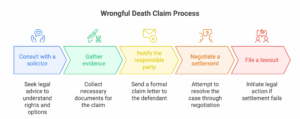Losing a loved one is devastating. When that loss is due to someone else’s carelessness or wrongdoing, the grief can be compounded by anger and a sense of injustice. A wrongful death claim seeks to address this injustice, providing financial compensation to those left behind. This isn’t about putting a price on a life; it’s about acknowledging the impact of the loss and helping secure the future for the deceased’s dependents.
Understanding Wrongful Death: Defining the Loss
A wrongful death occurs when someone dies as a result of another person’s negligence, recklessness, or intentional act. This could stem from a car accident, medical malpractice, workplace accident, or even a criminal act. Unlike a regular accidental death, a wrongful death carries the element of culpability – someone else is responsible.
For example, imagine a construction worker killed because their employer failed to provide adequate safety equipment. Or consider a patient who dies due to a doctor’s misdiagnosis and subsequent incorrect treatment. These are both potential wrongful death situations.
Who Can File a Wrongful Death Claim?
Not just anyone can bring a wrongful death claim. Typically, it’s the deceased’s close family members, such as:
- Spouse or civil partner
- Children (including adopted children)
- Parents
- Dependants (those financially reliant on the deceased)
The specific rules vary slightly across different parts of the UK (England & Wales, Scotland, and Northern Ireland), so it’s crucial to understand the laws that apply in your specific jurisdiction. In some cases, a personal representative of the deceased’s estate can file the claim.
Establishing Negligence in a Wrongful Death Case
To succeed in a wrongful death action, you need to prove negligence. This means demonstrating that:
- The defendant owed a duty of care to the deceased.
- They breached that duty of care.
- That breach directly caused the death.
- Damages (financial losses) resulted from the death.
For instance, in a car accident case, you’d need to show that he other driver had a duty to drive safely, they breached that duty by speeding or running a red light, and that breach directly caused the accident that led to the death.
Pre-existing conditions can complicate matters. While they don’t necessarily invalidate a claim, they can affect the assessment of damages. The legal team will have to prove that the negligent act either directly caused the death or significantly hastened it.
Calculating Damages in a Wrongful Death Claim
Compensation in a wrongful death case is designed to cover the financial and emotional losses suffered by the surviving family. This can include:
- Loss of earnings: This covers both past earnings lost between the time of the injury and the deceased’s death, as well as future earnings the deceased would have likely earned. Expert financial analysts are often used to project future earnings, taking into account factors such as age, occupation, and career trajectory. A young, high-earning professional’s death, for example, would typically result in a larger settlement than that of someone near retirement age with a lower income.
- Loss of services: This accounts for the value of the services the deceased provided, such as childcare, household maintenance, and elder care.
- Funeral expenses: The costs associated with the funeral and burial.
- Loss of consortium/companionship: This addresses the emotional distress and loss of companionship suffered by the surviving spouse and family. Proving this often involves detailing the nature of the relationship and the emotional impact of the loss.
- Bereavement award: A fixed sum (currently around £15,120 in England and Wales for spouses and parents of children under 18) paid to close relatives.
Specific examples matter. Imagine a stay-at-home parent who dies in an accident. While they didn’t have a direct income, their contributions to the household (childcare, cleaning, cooking) had a significant value that can be calculated.
The Wrongful Death Claim Process: Step-by-Step
- Consult with a solicitor: This is crucial to understand your rights and options.
- Gather evidence: Collect documents like the death certificate, police reports, medical records, and financial records.
- Notify the responsible party: Send a formal letter of claim to the defendant or their insurance company.
- Negotiate a settlement: The majority of cases are settled out of court through negotiation.
- File a lawsuit: If a settlement cannot be reached, a lawsuit may be filed.

The statute of limitations (time limits for filing a claim) varies depending on the circumstances and location, so acting quickly is crucial.
Settling a Wrongful Death Claim vs. Going to Trial
Most wrongful death claims are settled out of court through negotiation with the insurance company. This is generally quicker and less expensive than going to trial. However, insurance companies often attempt to minimise payouts, so strong negotiation skills are crucial. Strategies for negotiating include having a well-documented case, understanding the value of your claim, and being prepared to go to trial if necessary.
Going to trial is a more formal and lengthy process, but it may be necessary if a fair settlement cannot be reached.
Seeking Legal Assistance for Your Wrongful Death Claim
Wrongful death cases are complex. A solicitor specialising in these claims can provide invaluable assistance by:
- Investigating the circumstances of the death.
- Gathering evidence and building a strong case.
- Calculating the full extent of damages.
- Negotiating with insurance companies.
- Representing you in court if necessary.
- Providing emotional support and guidance during a difficult time.
They can also advise on state-specific laws and their impact on your case. Experienced legal counsel levels the playing field against powerful insurance companies, giving you the best chance of securing the justice and compensation you deserve. Don’t hesitate to seek their help during this challenging time.




Have you ever considered about adding a little bit more than just your articles? I mean, what you say is fundamental and all. Nevertheless think of if you added some great images or videos to give your posts more, “pop”! Your content is excellent but with pics and videos, this website could certainly be one of the very best in its field. Great blog!